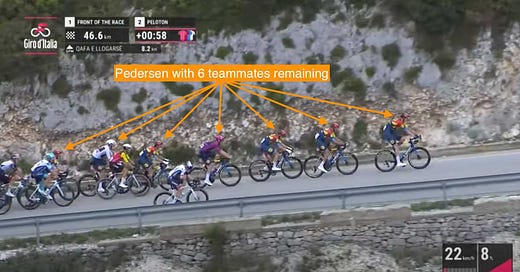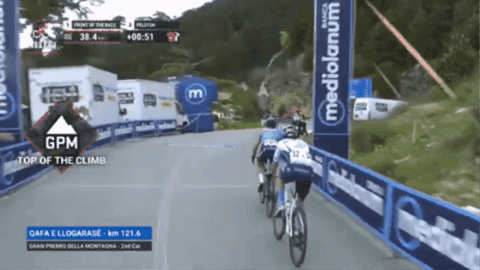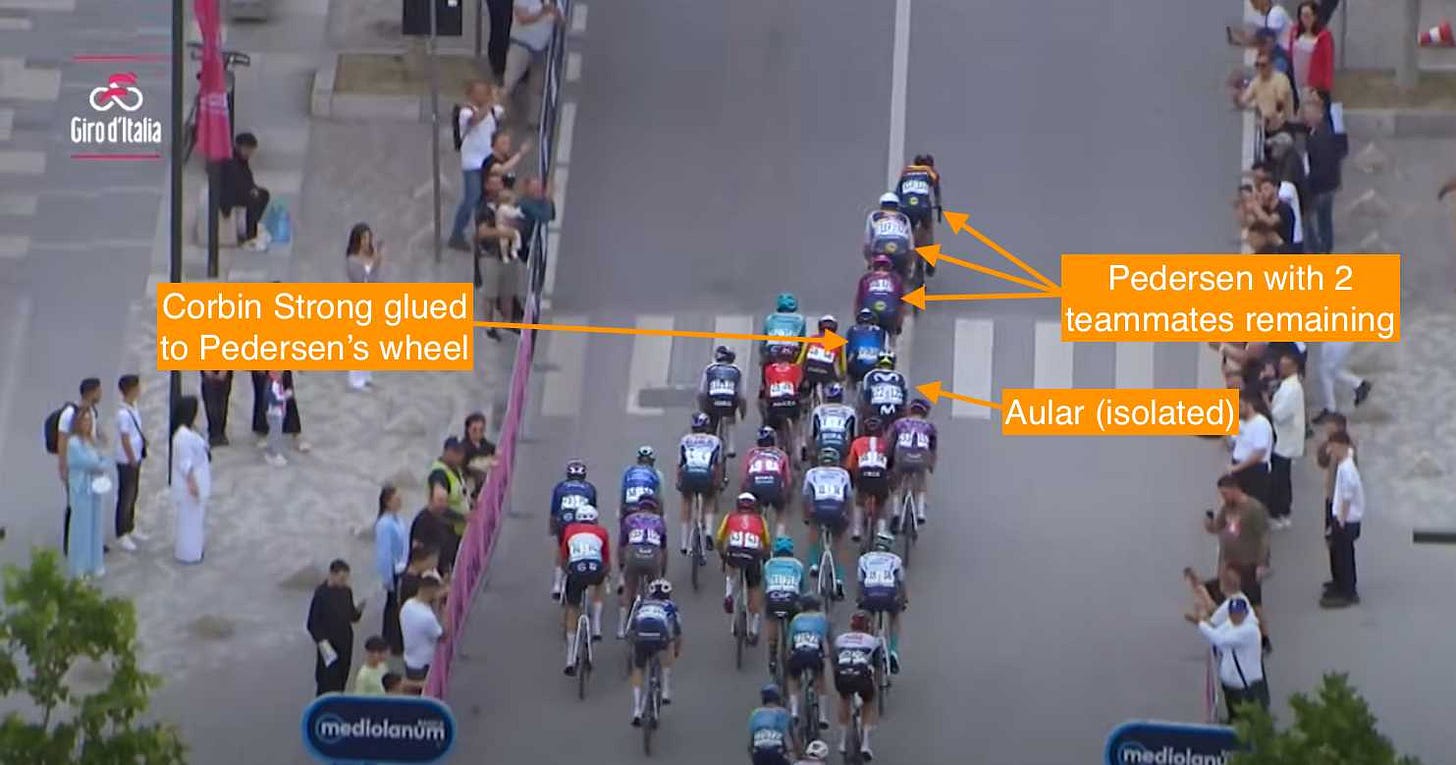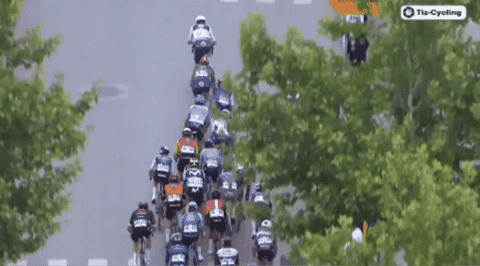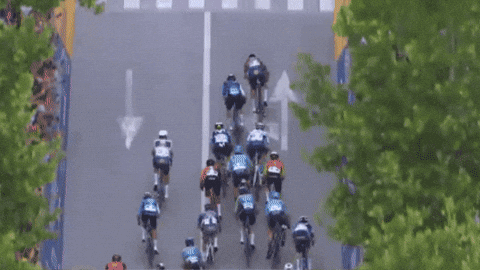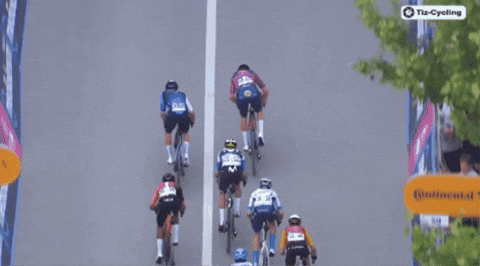Key Takeaways: 2025 Giro d'Italia Stage 3
Breaking down how tactical control & raw power delivered a stage win
Mads Pedersen claimed his second stage win of the 2025 Giro d’Italia in Vlorë, alongside the glistening Adriatic coastline, at the end of a stage where the peloton snaked through the lush mountains of southern Albania and his Lidl-Trek team methodically controlled the final climb and run-in to the finish. With the ten-second time bonus that came with the victory, Pedersen was able to leverage his strong Stage 2 time trial to reclaim the race lead from Primož Roglič, who appeared more than happy to hand over the jersey so that he and his Red Bull-Bora-hansgrohe squad could slide back into the peloton and shift their focus to the GC stages looming at the end of the first week.
Check out the key moments and takeaways from the stage below:
Stage Top Five:
1) Mads Pedersen (Lidl-Trek) +0
2) Corbin Strong (Israel-Premier Tech) +0
3) Orluis Aular (Movistar) +0
4) Brandon Smith Rivera (INEOS Grenadiers) +0
5) Edoardo Zambanini (Bahrain-Victorious) +0
GC Top Five:
1) Mads Pedersen (Lidl-Trek) +0
2) Primož Roglič (Red Bull-BORA-hansgrohe) +9
3) Mathias Vacek (Lidl-Trek) +14
4) Brandon McNulty (UAE Team Emirates-XRG) +21
5) Juan Ayuso (UAE Team Emirates-XRG) +25
BTP’s Spring Classics Coverage is brought to you by JOIN Cycling
The JOIN Cycling App is a smart training platform that adapts to your schedule, goals, and fitness level, offering dynamic, science-backed workouts. It’s perfect for cyclists of all levels, balancing training and recovery efficiently. With AI-driven adjustments and flexibility, JOIN helps you stay motivated and improve consistently. Redeem a free month through our special BTP link.
Stage 3 Race Notebook
BTP is seamlessly following every twist and turn of the Giro d’Italia with the fantastic Tour Tracker app (iPhone/Android/Web)
115.7km-go-to: The Red Bull-Bora-hansgrohe team of race-leader Primož Roglič and the Lidl-Trek team of stage favorite, a race lead hopeful, Mads Pedersen, have each parked a rider on the front to keep the gap to the early breakaway in check. This is almost certainly a premeditated agreement between the two teams, since it gives Red Bull-Bora a powerful ally to keep the breakaway from getting out of hand, and ultimately lessens the total output required from both teams by aligning incentives.
46.6km: When they hit the final, and toughest, climb of the stage, Lidl-Trek still has almost a full team surrounding Pedersen, who is climbing incredibly well and staying near the front with apparent ease. And with Dan Hoole averaging roughly 475 watts on the front (6w/kg), the ground any potential attack can gain is severely limited, meaning there is little anyone else can do to disrupt Pedersen’s march toward eventual victory.
45.7km: Lorenzo Fortunato eventually attacks with Pello Bilbao following close behind, but this further plays into Lidl-Trek’s hands since they quickly build up a gap of just over half a minute, which deters further attacks, as any chaser would need extreme confidence in bridging the gap to have a chance at victory and avoid being stuck in no-man’s land.
38.4km-37.8km: When they crest the top of the climb, Bilbao and Fortunato have just under a minute on the peloton, which is now being led by an impressive-looking UAE team, which is working to keep Juan Ayuso up front and out of trouble on the descent. Meanwhile, Roglič is more isolated and out of position further back.
20.7km: Coming off the descent, Lidl-Trek has things under control with four riders remaining to reel in the escapees, whose lead is down to just 15 seconds.
900m: Entering the final kilometer, Pedersen is perfectly positioned in third wheel, with two teammates remaining to lead him out. Behind, his two biggest rivals, Corbin Strong and Orluis Aular, are both isolated and forced to fight for wheels.
400m: As Mathias Vacek unleashes a strong leadout, Pedersen has a completely uninterrupted build-up while Strong and Aular jostle for position on his wheel.
175m: As Vacek pulls off, Pedersen launches his sprint while Strong follows.
100m: While Strong is close behind, Pedersen’s advantageous position means that he has an effective head start and that Strong has to generate a massive amount of speed to pull even with him.
Finish: Strong stalls out and holds on for second while Pedersen sprints straight through the line to get his second stage win of the race (and 8th career Grand Tour stage win).
Three Key Takeaways
1) Mads Pedersen Is Quickly Becoming One of the Sport’s Most Versatile & Prolific Riders: After today’s stage, it is clear that Mads Pedersen is in the best form of his career, and possesses a level of raw power that makes him nearly unbeatable when he hits the front with a clear line to the finish.
Along with the coordination and strength of his Lidl-Trek team, which allows Pedersen to sit calmly in the wheels as his rivals fight for position behind, and to get an effective head start in the sprint, he looks as close to unbeatable in these hilly stages as a rider can be.
Also, his versatility to get over the toughest climbs while being fast enough to finish things off has essentially seen him take over the ultra-versatile vertical that was once the sole domain of Wout van Aert.
For example, since 2022, Pedersen has racked up 10 top tens in Monuments to Van Aert’s 8, and so many Grand Tour stage wins (8), that he is currently sitting in third place overall amongst active riders over the same timeline.
Most Grand Tour Stage Wins Since Start of 2022 Season:
Tadej Pogačar: 17
Jasper Philipsen: 9
Mads Pedersen: 8
Kaden Groves: 8
Remco Evenepoel: 8
Primož Roglič: 7
Wout van Aert: 6With Pedersen currently displaying an incredible level of fitness, as well as multiple stages remaining that suit his skills, it isn’t out of the question that he moves into second place on this list before the end of the race.
2) The Stage’s Design Meant Potential Attacks Had Nowhere to Go: While the stage might have looked ripe for an attacking bonanza to contest the stage and take time in the GC, a closer look would have revealed that this was nothing but a mirage, with a few factors making any attacking tactics futile.
Firstly, the pace of Lidl-Trek was too high to allow any attackers to gain significant time by the top of the climb.
The team perfectly threaded the needle on the final climb, setting a hard enough pace to deter attacks and/or keep attacking riders from getting an insurmountable gap, but not too hard that it dropped riders they would later need to control the run-in and lead out Pedersen in the sprint.
Secondly, none of the other teams that might have wanted to make the climb harder to contest the stage, like Q36.5, had the firepower to lift the pace above what Lidl-Trek was already doing.
And, when we saw Tom Pidcock, one of the strongest non-GC contenders in the race, attack near the top of the climb, he was quickly and easily marked by Lidl-Trek’s Giulio Ciccone, rendering the move moot.
Thirdly, no serious GC contenders could realistically have been dropped on today’s climb, and, even if they had an issue, their run to the finish was far too long from the top of the climb to hold off a full team chase.
In a 21-stage race, saving energy is key, and it was not worth it to spend any more than needed today.
And while it was easy to point to the opening stage as an example of splits happening on a much easier climb, it is important to remember that on Stage 1 the climb topped out 10 kilometers from the finish line, with most of that distance being a fast descent.
In contrast, today’s climb topped out nearly 40 kilometers from the finish line, with 20 kilometers of that being high-speed flats.
This extra distance and the presence of a nearly full and highly motivated Lidl-Trek means that any escapees light enough to pull out of a gap on the climb would have lacked the raw power on the flats to hold them off, and been mowed down as a result.
3) The Strategic Alliance Between Red Bull-Bora-Hansgrohe & Lidl-Trek Allowed Both Teams to Minimize Their Workload: It might have looked strange to see Red Bull-Bora-hansgrohe expending resources to help Lidl-Trek control the stage, especially considering that they certainly wanted to get rid of the leaders’ jersey by the end of the stage.
However, by striking a deal to share pacemaking with Lidl-Trek, they secured an extremely powerful partner, and eliminated any chance that a strong breakaway would turn the stage on its head and see a rider build up a huge, unexpected advantage, just like Ben O’Connor on Stage 6 of the 2024 Vuelta a España.
By working together, each team was able to pledge just a single rider to the pacemaking, which left Lidl-Trek a large squad to control the pace on the final climb and lead out Pedersen, and allowed Red Bull-Bora to conserve the legs of other riders until later in the race.
And the outcome will suit both teams, with Roglič happy to give the jersey away to a strong team for a few stages to allow his team to avoid pacemaking responsibility until the first summit finish, while Pedersen and Lidl-Trek will be thrilled to have the race lead back, which is a massive reward for their excellent work thus far and the most realistic ceiling for their Giro.
Stage 4 Preview
With the peloton getting an early rest day tomorrow for the transfer across the Adriatic Sea to Italy, the next stage will be on Tuesday, and will likely serve up a bunch sprint in the ancient southern Italian city of Lecce.
The less mountainous course means that Pedersen and Lidl-Trek will face far tougher competition in the final sprint, with riders like Olav Kooij and Kaden Groves back in the mix.
Prediction: Behind his powerful leadout, Pedersen takes his third stage win ahead of Olav Kooij and Kaden Groves.

